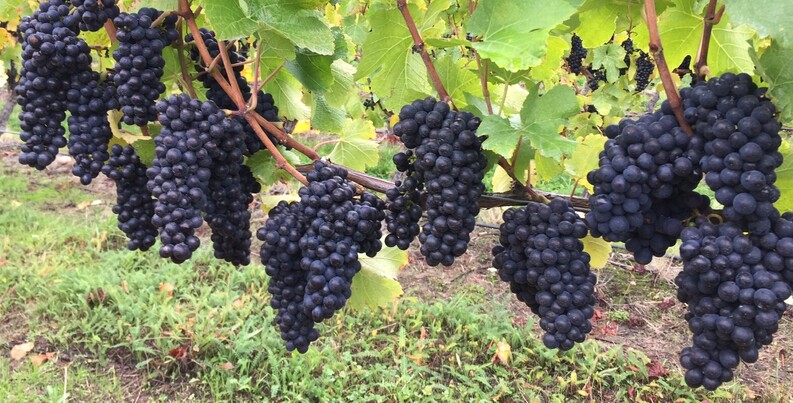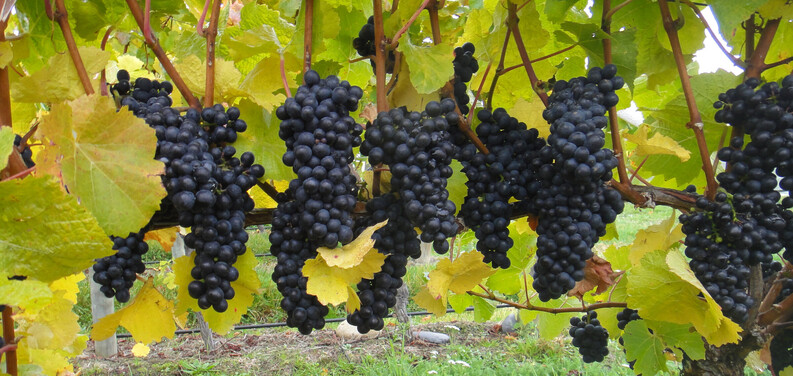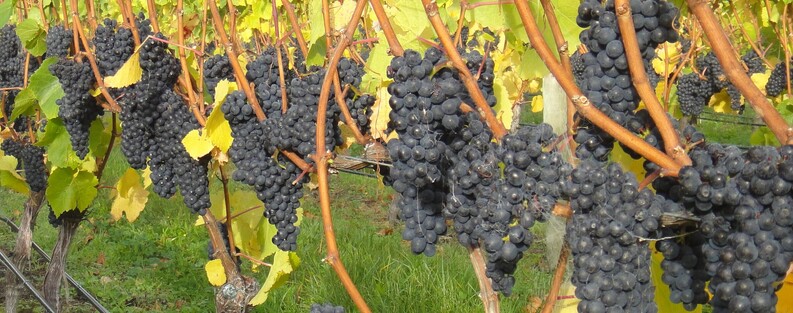
Here we look at the interesting story behind Pinot Noir and why Grasshopper Rock is dedicated to Pinot Noir.
Pinot Noir is one of the world’s oldest known grapes and its origins go back centuries to northeast France and most notably the Burgundy and Champagne regions. It seems likely Pinot Noir originated from the domestication of wild vines growing there but not everyone agrees on this and some believe it was brought by invaders from Lombardy.
Pinot Noir is unquestionably the most expressive of all noble red grapes of the world. Noble grapes gained their title because they form the cornerstone of winemaking in the last few centuries, and they have a heightened ability to express where they are grown. The leading six noble grapes are: Cabernet Sauvignon, Merlot, Pinot Noir, Chardonnay, Sauvignon Blanc, and Riesling.
Why might Pinot Noir be the most expressive of all?
One reason is the physiological difference between Pinot Noir grapes and Cabernet Sauvignon and Merlot. Pinot Noir grapes have thinner skin compared to Cabernet Sauvignon and Merlot’s thicker skin. Skin thickness has a major influence on how much heat is required to ripen the skin so that they taste ripe and are not bitter and astringent.
Pinot Noir with its thinner skin takes less heat to ripen. It would be very risky trying to consistently ripen Cabernet Sauvignon in Central Otago’s cool climate and it has been tried but with very unreliable results.
Individual Pinot Noir berries are smaller than other red varieties and therefore have higher skin surface area to berry volume ratio. Pinot Noir contains a higher percentage of flavour and aroma precursors in its pulp than other red varieties. Pinot Noir can therefore make a less tannic red wine. Whereas Cabernet Sauvignon due to its thicker skins has a higher ratio of skin bulk to berry bulk and will therefore yield less juice per Kg of fruit. With most of the tannins in the skin this creates a very different wine.
One of the implications of the different ripening time requirements is decisions around where to grow grapes. As noted, Cabernet Sauvignon struggles to ripen in Central Otago whereas it makes fantastic wines in hotter climates where there is sufficient heat to ripen but still has some cooler nights to slow the ripening. Cooler, slower ripening has an important influence on flavour and aroma precursors and increases the expression of site or location in the wine.
With Pinot Noir, Central Otago has the ultimate opportunity to produce the “most expressive of all” red wines.
· It needs less heat to ripen so we can plant it in the coolest places.
· Not only can we get it fully ripe but more importantly can ripen it slowly due to our very cool nights (below 5 degrees) in the autumn.
· Slow ripening maximises the flavour and aroma precursors in the grapes, leading to wines of great complexity and elegance.
Cool climate, slow ripening to full ripeness, produces the most expressive grapes and therefore wine.

Grasshopper Rock was established in 2003
The decision by Grasshopper Rock to plant Pinot Noir in Central Otago was made because it was the place in New Zealand where we believe Pinot Noir can consistently be at its most expressive. In other words, the world’s most expressive red grape grown in a location where it could be at its most expressive,- a cool, dry, disease free climate.
The decision to purchase and plant the site was based on a long history of climate data for the site and the performance of other vines grown nearby and in fact on this site in the late 1860’s. (Further article here)
The vision was always to focus on a single vineyard Pinot Noir and to produce a wine which would, with time, be recognized as a unique expression of Pinot Noir that only this site can produce.
Grasshopper Rock is now known for its consistently elegant and age-worthy Pinot Noir.
To create a unique expression from the land is a little like an artist selecting a palate of materials and colours to create a work of art. However, the vigneron has one chance to decide where to place vines, different rootstock, and clones when they plant the vineyard as we did in 2003. The rest is up to mother nature to mould a complex mix of soils, meso-climates, clones, rootstocks, and weather into a small ripe grape packed with all the precursors for maximum flavour and aroma complexity.
A Pinot Noir vineyard is not a white sheet of paper. It is a complex natural environment which means the very best cannot be replicated.
Grasshopper Rock is a great example of this complexity. The vineyard site includes three different soil profiles which influence vine vigour and three main mesoclimates defined mainly by temperature variation during the day and time of the year. The vines are all Pinot Noir, but each vine is also a particular clone of Pinot Noir (more on this later). We have six different clones. Each clone brings slightly different characters to the wine. Each Pinot Noir clone is grafted onto a disease resistant rootstock. We have several different rootstocks planted and each rootstock tends to bring slightly different vigour to the vine depending on the soil type.
A walk through the vineyard in the weeks before harvest tasting berries highlights the variation in flavours and tannins from one part of the vineyard to another and yet these are all Pinot Noir grapes. It is a real eye opener for those who have not experienced it. It is this variation and balance that creates great wine in the same way an artist looks for balance.
Conclusion
Back to the question, why is Grasshopper Rock dedicated to Pinot Noir?
We wanted to create something which, like an artist, is a unique expression of who we are. We have connected a great vineyard site with the world’s most expressive red grape and delivered a Pinot Noir which says it comes from Grasshopper Rock.
Phil Handford
More Pinot Noir information
The name. The Pinot Noir name is derived from the French words for pine and black after the small black pinecone like appearance of ripe, tightly clustered, Pinot Noir bunches.
Propagation. Grapevines are propagated vegetatively, so all Pinot Noir vines are genetically identical to each other and to the single original seedling from which the cultivar originated. Somatic mutations of Pinot Noir have produced Pinot Gris, Pinot Blanc, and Pinot Meunier which have been propagated to become distinct varieties.
Clones. Six Pinot Noir clones are planted at Grasshopper Rock. Because grapevines are propagated vegetatively each clone is the same as the parent source. Four of our clones originate directly from France (Dijon Clones) 114, 115, 667 and 777. One clone was developed by UC Davis’s Foundation Plant Services and the original source is Ch de Pommard, Pommard, France, Pommard clone FPS 05 or clone 5. One clone is Abel clone, also known as Ata Rangi or “Gumboot” clone and is thought to have been taken from Romanee-Conti, Burgundy and came into New Zealand via an incoming passenger when it was seized by NZ Customs.

